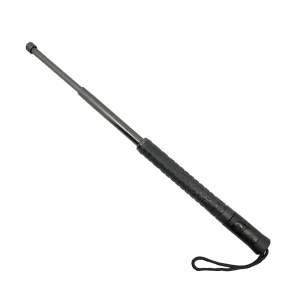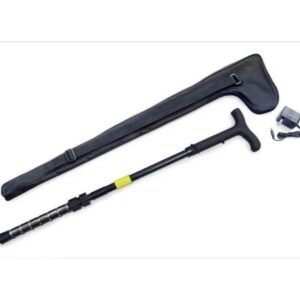Comprehensive Guide to Self-Defense Walking Sticks
Introduction to Self-Defense Walking Sticks
Definition and Purpose
Self-defense walking sticks, a remarkable blend of practicality and protection, have emerged as essential tools for personal safety. These sticks, going beyond the traditional role of aiding in mobility, are ingeniously designed to provide an added layer of defense. Equipped for both the elderly and anyone seeking an unassuming yet effective means of self-protection, these walking sticks serve a dual purpose: they support physical movement and act as a deterrent against potential threats.
Historical Background
The history of using walking sticks for self-defense traces back centuries. Originally, they were mere wooden staffs, used by travelers and shepherds for protection against wildlife and bandits. Over time, these sticks evolved, incorporating elements from martial arts and personal defense techniques. Today, they represent a sophisticated fusion of historical practices and modern design, making them more than just mobility aids.
Types of Self-Defense Walking Sticks
Traditional Designs
Traditional self-defense walking sticks are often crafted from robust woods, like oak or hickory, and are admired for their classic aesthetic. Many of these sticks retain a natural look, sometimes featuring simple carvings or engravings. Their strength lies in their simplicity and the natural weight and sturdiness of the wood.
Modern Innovations
In contrast, modern self-defense walking sticks boast advanced materials like aluminum or reinforced plastics, catering to a more contemporary audience. These sticks often come with additional features like hidden compartments, LED lights, or even stun capabilities. Their lightweight nature makes them ideal for quick maneuverability, without compromising on strength.
Key Features of Self-Defense Walking Sticks
Material and Durability
The efficacy of a self-defense walking stick largely depends on its material. Wooden sticks are prized for their natural strength and durability, while metal or composite materials offer lighter weight and sometimes greater flexibility. The choice of material affects not only the stick’s longevity but also its usability in various self-defense scenarios.
Size and Portability
Size and portability are crucial in selecting the right stick. It should be tall enough to provide support while walking but not so large as to become cumbersome. Portability is particularly important for those who travel frequently or need to carry the stick in different environments.
Additional Features
Many self-defense walking sticks come with additional features that enhance their utility. Ergonomic handles, non-slip grips, and adjustable lengths are common. More advanced models might include tactical elements like concealed blades, pepper spray compartments, or even tasers, though these features should be chosen with an understanding of local laws and personal comfort with such devices.
How to Choose the Right Self-Defense Walking Stick
Assessing Your Needs
Choosing the ideal self-defense walking stick starts with a clear understanding of your needs. Are you looking for something primarily for mobility support, or is self-defense your primary concern? Maybe you need a balance of both. Consider your daily routine, the areas you frequent, and the level of threat you perceive in these environments.
Considering Your Physical Capabilities
It’s also crucial to consider your physical capabilities. The stick should complement your strength and agility. For those with limited strength, a lighter stick might be more appropriate. Conversely, if you’re capable of handling a heavier stick, you might opt for one made of sturdier material for added impact in self-defense situations.
The Legal Aspect of Self-Defense Walking Sticks
Understanding the Law
Before purchasing a self-defense walking stick, it’s vital to understand the legal implications. Laws regarding the carrying and use of self-defense tools vary widely across regions. Some areas might have restrictions on features like concealed blades or stun capabilities. It’s important to be informed about local laws to avoid legal complications.
Carrying and Usage Guidelines
Apart from legal restrictions, it’s wise to familiarize yourself with best practices for carrying and using a self-defense walking stick. This knowledge ensures that you can confidently and responsibly use your stick, both as a mobility aid and a self-defense tool.
Training and Usage Tips
Basic Techniques
Proper training is key to effectively using a self-defense walking stick. Basic techniques often include understanding the correct grip, stance, and ways to block or strike an assailant. Even simple maneuvers can be highly effective when executed correctly.
Advanced Strategies
For those interested in more advanced techniques, many self-defense courses offer specialized training with walking sticks. These strategies might involve disarmament techniques, pressure point targeting, and combining the stick’s use with other self-defense tactics.
Benefits of Using a Self-Defense Walking Stick
Physical Benefits
Self-defense walking sticks not only mobility aids but also offer physical benefits. They can improve balance, reduce the strain on joints and muscles, and provide a means of exercise through walking. In a self-defense scenario, they offer a significant advantage, extending your reach and providing a means to fend off an attacker.
Psychological Advantages
The psychological benefits of carrying a self-defense walking stick are equally noteworthy. Knowing you have a tool for protection can boost confidence, reduce fear, and provide a sense of security. This psychological edge often proves crucial in deterring potential threats.
Potential Drawbacks
Limitations
While self-defense walking sticks are versatile, they do have limitations. They might not be suitable in every self-defense situation, and relying solely on them is not advisable. It’s important to recognize these limitations and consider additional self-defense strategies.
Misuse Concerns
There’s also the potential for misuse. A self-defense walking stick is a responsibility, and improper use could lead to legal consequences or unintended harm. It’s essential to use these tools with caution and respect.
Testimonials and Case Studies
Incorporating real-life testimonials and case studies offers valuable insights into the practical use and effectiveness of self-defense walking sticks. These stories can provide perspective on how individuals have used these tools in various situations, highlighting their versatility and utility.
Maintenance and Care
Like any tool, self-defense walking sticks require proper maintenance and care. This section will cover essential tips on preserving the stick’s condition, ensuring it remains reliable and effective over time.
Where to Purchase
This part of the article will guide readers on where to find quality self-defense walking sticks, discussing both online and brick-and-mortar options. It will also offer advice on what to look for when making a purchase.
Conclusion
The conclusion will summarize the key points covered in the article, reinforcing the importance and utility of self-defense walking sticks. It will also encourage readers to consider their safety and how a self-defense walking stick might fit into their lifestyle.
FAQs
- What are the legal considerations for carrying a self-defense walking stick?
- How effective are self-defense walking sticks against an attacker?
- Can anyone use a self-defense walking stick, or does it require special training?
- What are the key features to look for when purchasing a self-defense walking stick?
- How do self-defense walking sticks differ from regular walking sticks?



